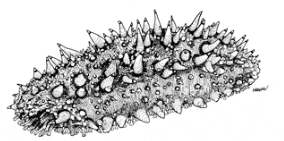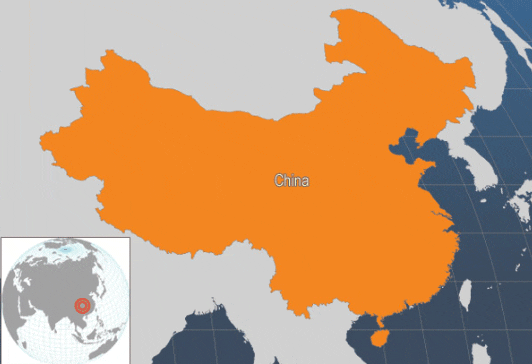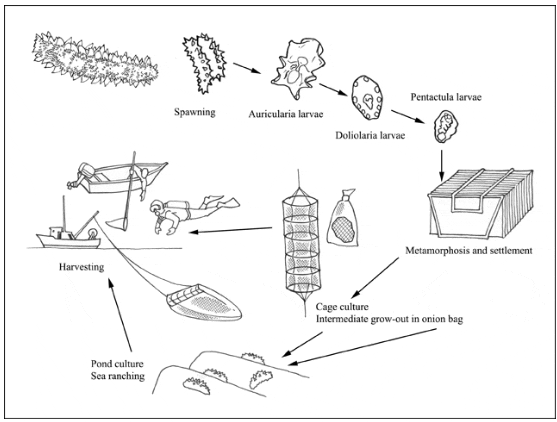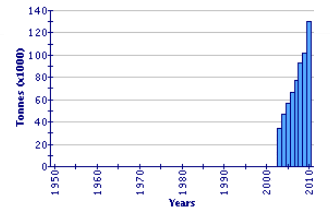Identity
Stichopus japonicus Sel, [Stichopodidae]
FAO Names: En - Japanese sea cucumber, Fr - Bèche-de-mer japonaise, Es - Cohombro de mar japonés

Biological Features
Large (20-30 cm length). Number of oral tentacles 20. Numerous dense tube-feet in three rows on the abdominal surface. Tall and small papillae in six rows indistinctly along dorsal and lateral surfaces. Three different colour types exist and the red type is thought to be genetically different from the green and black types.
Profile
Historical Background
The Japanese sea cucumber has been produced since the 16th century in China (where it is considered as a tonic rather than seafood) and since the 8th century in Japan. Capture fisheries production of this species in Japan and the Republic of Korea peaked in 1968 when 14 300 tonnes were landed from the capture fishery. After that landings decreased gradually to 7 655 tonnes by 1992. However, with the economic development of China, a major consumer of Stichopus japonicus, the total catch in these two countries dramatically increased to 11 958 tonnes in 2006. There are no available FAO statistics of fishery production in China but it is estimated 436 tonnes was landed in 2002.
Artificial seed production begun in the 1950s and developed in the 1980s in China. Between one and two billion juveniles were produced in 2004 and 92 567 tonnes were harvested in 2008. In Japan, seed production started at almost at the same time and 3.5 million juveniles were produced in 2008. These juveniles have been released to the fishery grounds for sea-ranching.
Main Producer Countries

Main producer countries of Stichopus japonicus (FAO Fishery Statistics, 2008)
Habitat and Biology
Japanese sea cucumbers are found in shallow coastal sea bottoms from the intertidal zone to 80 m depth in northern regions of the Pacific coastal waters of Japan, northeastern China, the Korean peninsula, Sakhalin, Kuril Islands and Alaska. The red and green types are commercially valuable but the black one is less so. The red type is found mainly amongst the rock, pebble and gravel areas towards the open sea but the green and black types are found on sandy and muddy/sandy grounds near the shore. Spawning occurs in the spring (~March) in the south of Japan and the summer (~July) in the north, when the water temperature reaches 13-22 °C. Planktonic larvae (auricularia stage) feed on phytoplankton and develop to 1 mm, which is the maximum size, in 8-12 days after hatching. They then shrink to 400 to 500 µm and metamorphose to the doliolaria stage. Doliolaria larvae quickly (~1 day) metamorphose into pentactula larvae and are ready to settle on the substratum. In natural conditions, growth rate varies according to the location. In Hokkaido, the northern part of Japan, sea cucumbers take 3.5-4.5 years to grow to 100 g and 5-6 years to grow to 200 g. In Aomori, southern Hokkaido, it takes almost 1-2 years less to reach each of these size categories.
Production
Production Cycle

Production cycle of Stichopus japonicus
Production Systems
Seed Supply
Natural seed is collected in the spawning season using polyethylene bags packed with oyster shells and/or scallop shells and artificial screens made of polyethylene as settlement materials. These are suspended from ropes in the sea. The number of juveniles collected fluctuates annually. Due to this fluctuation, hatchery-raised juvenile production is more popular.
Hatchery Production
Broodstock for hatchery use are obtained from natural stocks. Fully matured broodstock in the spawning season can be used for gamete collection immediately. To induce maturation, broodstock are reared for several months at a density of 25-10/m3 and fed with powdered brown algae. Maturation is judged by the egg diameter (>150 um) and sperm formation in the gonads.
Gametes are obtained by thermal stimulation in Japan. The broodstock are set individually in 15 litre containers and/or 20-30 broodstock are placed in 100 litre tanks filled with sea water and the temperature is raised to 5 °C higher than the normal rearing temperature. The released eggs are fertilized within 2 hours. Suitable sperm and egg densities are 10 000 sperms/ml and 10 eggs/ml, respectively. The fertilized eggs are washed to remove excess sperm and left to hatch out for about 18 hours without aeration. The hatched blastulae swim to the surface and are transferred to larval rearing tanks at a density of 1-2/ml and fed microalgae (Chaetoceros gracilis) at ~10 000 cells/larvae/day until they are ready to set onto collectors (10-14). In China, broodstock are kept in large spawning tanks at 30/m3 and the temperature is raised to 19 °C at a rate of 1 °C/day. After seven-ten days the broodstock will spawn at night. Eggs are carefully washed by draining the water and replacing it. The hatched larvae are transferred to larval rearing tanks at 300/litre.
For larval food, 2-5×105 cells/ml of Dunaliella sp. and some diatoms, are used. The optimum temperature for larval rearing is 18-22 °C. Fully developed metamorphosing larvae are collected on corrugated PVC plates and/or frame fitted screens made of polyethylene or polypropylene. Juveniles attach to these collectors and are fed natural diatoms and/or an algal powder made from Undaria pinnatifida in Japan or Sargussum thunbergii in China.
The growth rate of settled juveniles in rearing conditions is density dependent. At densities of 10 000 to 20 000/m3 it takes two-three months to reach 5-10 mm in body length. In Japan the food supply is gradually increased according to growth.
In China, juveniles are regularly transferred to new settling plates, to overcome the mortality that occurs through high density levels, and are sorted by size because they grow at different rates. The growth rate of juveniles in the Chinese hatcheries is more rapid than in Japan: 1 cm body length is reached in two months, 2-10 cm in several months. In China the rearing density of juveniles sized 3, and of those sized 3, which are about half the levels used in Japan.
Juveniles that have attained 2-3 cm in body length are transferred to ponds or for pen culture or are used for sea ranching in China (there is no grow-out farming of this species in Japan).
The quantity of seeds produced has reached 1-2 billion/yr in China and 3-6 million/yr in Japan.
The juveniles produced in Japan are then transferred to an intermediate culture stage or are released directly onto the fishery grounds. The intermediate culture continues throughout the winter until the following spring, either in the hatchery or in 1-2 mm mesh lantern nets suspended in the sea until they reach ~30 mm. All of the resulting animals are used for sea ranching.
Ongrowing Techniques
In China, hatchery raised juveniles are produced for stocking ponds, for pen and cage culture and for sea ranching. In Japan only sea ranching is used.
Pond farming
The ponds used for culture are located near to the sea shore. At high tide, the sea water flows into the ponds by gravity, together with natural feed (organic debris). At low tide, the water in the ponds is about 80-100 cm deep. The sea water is exchanged tidally by opening and closing sluice gates. For this type of aquaculture ponds are typically 1 to 4 ha and may be old ponds used previously for shrimp culture or new earthen ponds that have sandy or sandy-muddy bottoms with shelters made of stone blocks. Unpolluted, salinity 27-32 ‰ and 0-30 °C water is necessary. The sea cucumbers are stocked at 30-100/m2, depending on their initial body size. Aeration is provided. Juveniles of about 6 cm (10 g) that are released in March to May grow to ~150 g by October-November of the same year. However, seeds weighing
Pen culture
In this form of rearing, cages are hung under wooden rafts or placed directly on the sea floor and the sea cucumbers are fed with brown seaweeds (Sargassum sp.) and other macroalgae.
Sea ranching
Rocky sites with abundant macrophytes and sandy-muddy bottoms are preferred as release areas. Even though various experiments have been conducted, the effectiveness of stock enhancement has not yet been sufficiently determined in Japan. However, some experimental releases of juveniles have been shown to increase stock density in China.
Feed Supply
Microalgae for use as larval feeds are cultivated in the hatcheries, both in Japan and China.
Dried powdered macroalgae (Undaria pinnatifida) for feeding juveniles are commercially available in Japan. Mixtures of mud and ground algal powder of Sargussum thunbergii are prepared for juveniles in each hatchery and are also commercially available in China.
Harvesting Techniques
In Chinese pond culture the sea cucumbers have generally reached marketable two years after stocking and are harvested by diving and/or drainage.
Handling and Processing
Harvested sea cucumbers are kept in holding tanks for one night to allow the excretion of their faeces before transport to the processing plants. The abdomen is cut open and the entrails are removed in the processing plant. The guts are washed to remove the faeces and added to ~15-20 percent salted water to make konowata (salt-fermented gut). Konowata is considered one of the three major chinmi (delicacies) of Japan. The gonads are dried for a few days and processed to form konoko (or kuchiko). These are expensive dainties in Japan. The bodies without entrails are boiled and dried for a few times to make trepang (dried sea cucumber). This process is similar in both Japan and China.
In additional to trepang, other products are marketed, including frozen sea cucumbers, freeze-dried sea cucumbers and nutrient supplements made from extracts.
Production Costs
The production cost of juveniles for sea ranching in Japan varies according to the size and production site. USD 6.10 to 44.00/100 individuals is typical in Japan. In Rongcheng city, Shandong Province, China, the cost of juveniles, which are almost twice as large as those used in Japan are USD 7.50-30.00/100. The number of Chinese hatcheries is increasing (2010), so this type of aquaculture seems to be profitable.
Diseases and Control Measures
In some cases antibiotics and other pharmaceuticals have been used in treatment but their inclusion in this table does not imply an FAO recommendation.
| DISEASE | AGENT | TYPE | SYNDROME | MEASURES |
| Acute peristomal oedema disease | Coronaviridae | Virus | Peristomal oedema & weakened adhesion capacity | No known treatment |
| Rotting edge symptom | Vibrio sp. | Bacteria | Darkening of body edge of auricularia larvae; beginning of autolysis | No known treatment |
| Stomach ulceration symptom | Unidentified bacteria | Bacteria | Ulceration of larval stomach walls leading to mortality | 3-5 ppm penicillin or streptomycin is effective, if permitted |
| Off plate syndrome | Vibrio spp. & unidentified bacteria | Bacteria | Settled juveniles shrink & lose ability to attach to substrate | No known treatment |
| Skin ulcer disease | Unidentified bacteria | Bacteria | Body shrinks & skin ulceration begins with small white patches | 3-5 ppm terramycin, acheomycin and sulphanilamides are effective if permitted |
| Bacterial ulceration syndrome | Gram-negative bacteria | Bacteria | Body shrinks & small lesions appear around the mouth; infected skin becomes eroded | No known treatment |
| Fungal disease | Fungus | Fungus | Papillae become white & then skin is eroded | No known treatment |
| Protozoan infection | Protozoa | Protozoa | Evisceration of Intestine & respiratory tree | No known treatment |
| Platyhelminthiasis | Unidentified platyhelminth | Platyhelminth | Ulceration around mouth & anus; subsequently spreading on body surface | No known treatment |
| Predation by copepods | Microsetella sp. | Copepod | Attacked juveniles have lesions on body & become weak & finally die | 1-2 ppm trichlorphon for 8-12 hours, if permitted |
| Predation by copepods | Tigriopus japonicus | Copepod | Attacked juveniles have lesions on body & become weak & finally die | Eliminate copepods to decrease this population by filtering water through 45 µm mesh |
Suppliers of Pathology Expertise
No specific laboratories but see the bibliography provided below.
Statistics
Production Statistics
Global Aquaculture Production of Stichopus Japonicus
(FAO Fishery Statistic)

Currently only China reports aquaculture production to FAO. The total value was USD 321.2 million in 2008.
Market and Trade
Captured S. japonicus in Japan are mainly exported to China via Hong Kong SAR as trepang and/or in salted form. Raw S. japonicus, salt-fermented gut (konowata), and dried gonad (konoko) are consumed locally in Japan. In 2009 Japan exported 240 tonnes of trepang; 97 percent were exported to Hong Kong SAR. The unit price was USD 435/kg. In Qingdao, China the retail price of trepang processed from aquaculture products was USD 380-824/kg in 2007.
Status and Trends
There is an increasing trend in Japanese sea cucumber aquaculture in China, which had reached 92 567 tonnes by 2008. Further development of farming and ranching of sea cucumbers is expected in both China and Japan, in order to satisfy Chinese demand. To sustain the expected increased production further development will be necessary, not only through technical improvements in aquaculture (for example shortening the cultivation period and reducing production costs) but also by keeping the production areas clean to prevent outbreaks of disease.
Main Issues
The following issues need to be addressed:
- Research needed to decrease the hatchery rearing period.
- Research needed to decrease the cultivation period to reduce production costs.
- Overexploitation of natural stock In China needs control to enhance the supply of good broodstock.
- The expanding of farming areas and increased output in China may induce the outbreak of diseases.
- The effectiveness of the sea ranching of sea cucumbers in Japan needs to be properly assessed.
Responsible Aquaculture Practices
A large number of broodstock should be used for the production of hatchery-raised juveniles in order to keep a large effective population size, thus preventing the loss of genetic variation and inbreeding depression around the release areas. Additionally, the increase of large-scale aquaculture requires that minimal and safe use of drugs and chemical substances should be ensured, as noted in the FAO Code of Conduct for Responsible Fisheries.
October 2012




